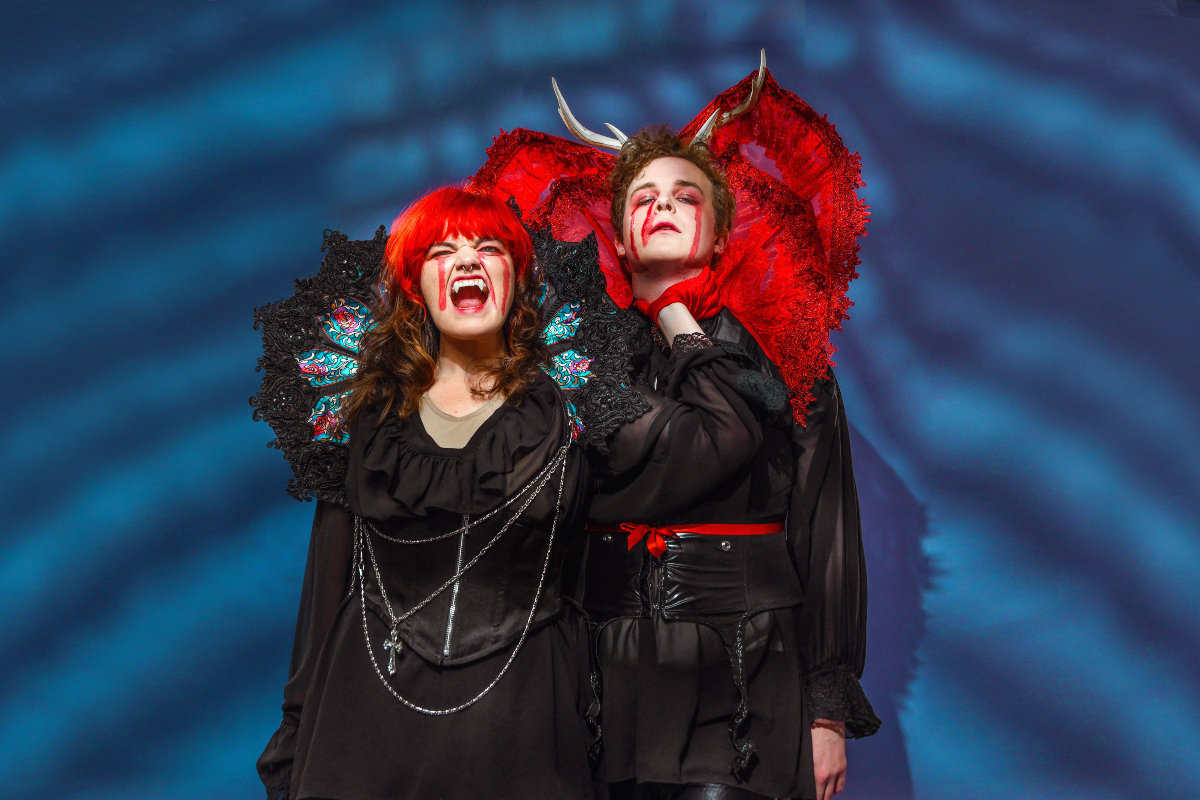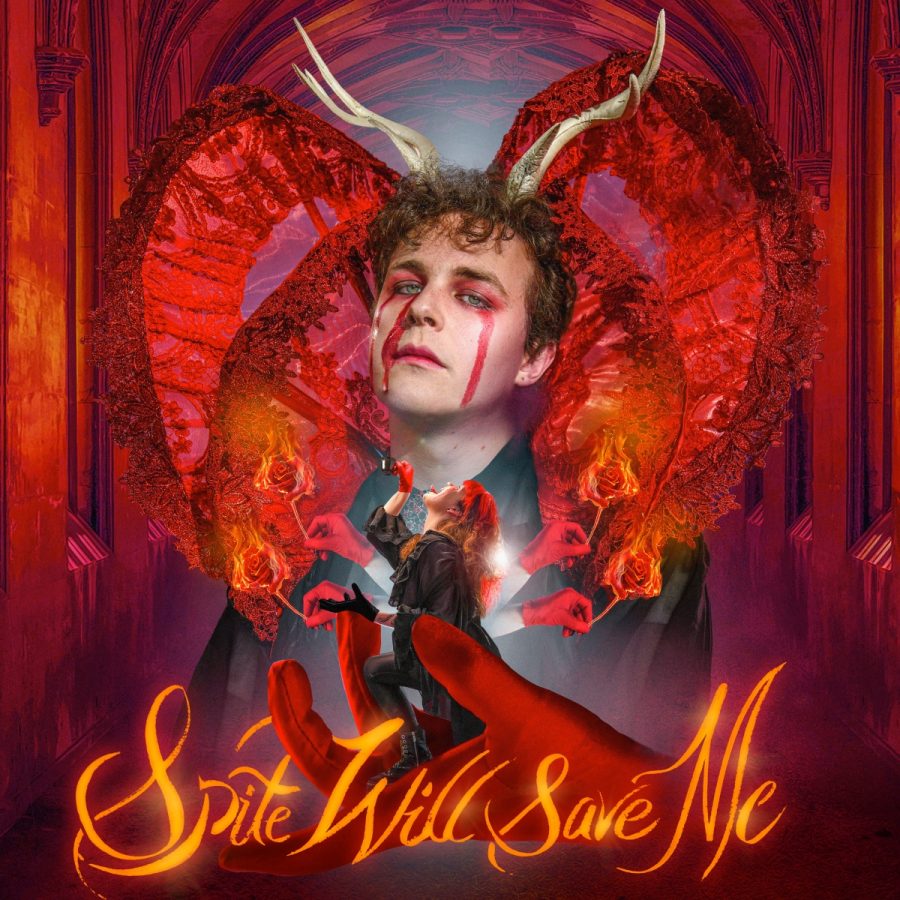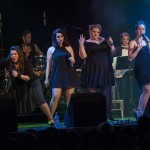Cry Club is creating a queer space for you to be whoever you want to be
By: Patrick Lenton

It’s hard to imagine on paper, but one of the most rock n’ roll moments in a Cry Club show is a PSA about crowd safety.
It’s at odds with traditional notions of live performance – think of stories of the Sex Pistols spitting on crowds, of violent moshes, of Iggy Pop cutting himself with broken glass on stage. But Cry Club as a band seem supremely and coolly unconcerned with any worries about traditionality in their music and performance.
Taking the time to confirm their show as a welcome and safe space, specifically for their queer audience, is profoundly rock.
Image: Giulia McGauran
Cry Club is a Melbourne-based queer duo, whose music joyously expands the boundaries of pop, rock and punk.
I was lucky enough to have breakfast with Heather Riley (they/them) and Jono Tooke (he/him) at a loud cafe to talk about their new album Spite Will Save Me, and how dramatically and consistently queer it is.
Much like their music, Heather and Jono are enthusiastic, opinionated and vibrant. They’re generous with their conversation, happy to get super nerdy about the music, but also happy to share themselves with me.
Their debut album God I’m Such A Mess is a sprawling collection of energetic queer joy, whereas they tell me that Spite Will Save Me – written entirely during COVID lockdowns – is drawing more on the idea of “queer wrath”.
It’s a brilliant album, perhaps a little more thematically cohesive than their first, but still happy to shift energy and references dramatically with each song. My utter favourite track, on loop since its release, is the ’80s glam inspired ‘Somehow (You Still Get To Me)’, full of delicious power chords and giving the vibes of an even gayer version of the original Top Gun.
When I mention the thorny issue of categorisation – are they electro pop, pop punk or glam rock? – I basically watch the light die in their eyes.
“We always get asked that,” Jono murmurs, while Heather shrugs and laughs.
It’s clear that unlike a lot of artists who proudly claim they are “pushing the boundaries”, Cry Club just doesn’t particularly care about them.
This brings us back to the live show’s PSA – these are boundaries they do take seriously. In the couple of live Cry Club gigs I’ve seen, they’ve used their song ‘DFTM (Don’t Fucking Touch Me)’, a rage-filled banger about being harassed at a concert, as a way to talk about consent and audience safety.
They’re earnest, but the message is still conveyed in a fun, crowd-banter way. They state that if an audience member is being bothered by someone, if there’s misogyny or bigotry happening, or if someone is harassing people and creating an unsafe environment – let them know.
“It’s about setting expectations for the audience,” Jono tells me. “I think it’s not necessarily us thinking we are protecting the fans, but more that we’re up here watching and not willing to let things slide.”
“Yeah, and I’m like, tiny,” adds Heather. “We’re not jumping into the audience.”
A Cry Club live show is a spectacle that must be experienced.
It has all the energy and joy of a tight and well-practiced rock show, but with spectacle, flair and humour that is entirely their own. The performance draws on Heather’s theatre studies background and Jono’s deep music lore – playing with aesthetics and physicality as much as the music.
Many of their songs, which I’ve enjoyed listening to in my own home, are given space to flourish and excel on stage. Heather and Jono are magnetic and charismatic, working in joyous harmony to provide an experience.
They tell me that many of their songs – if not the majority – are written with the stage in mind; the experience of how they want to perform them is given priority. It shows, because seeing Cry Club perform is astonishingly fun and engaging.
At the last Cry Club show I attended, where they were supporting US musician Betty Who, I looked around and saw all the indications of a robust queer audience: fabulous outfits, some twinks making out, a sea of people wearing flannel.
It seemed hard to find a single smidgeon of gender at all, which was incredibly delightful. I also noticed a lot of queer people on their own – a smattering of solo queer and trans people having a great time – and I realised it was a result of Cry Club’s commitment to creating a queer space. They set out not just to be queer inclusive or queer friendly, they create a space for queers, by queers.
Going out alone can be unsafe and unwelcoming for people who express their queerness loudly, especially trans people. So going solo to a concert would be up there in terms of anxiety-inducing situations. It’s no small feat that Cry Club has managed to cultivate the kind of space where people come to be themselves, and to express themselves.
Attending Club’s last gig made me reflect on the role of queer spaces, and the somewhat loaded term of “safe spaces” – the insinuation always comes back to protecting people from violence and outward expressions of homophobia and transphobia.
But as we know, there’s very little capacity to actually enforce a space free from that kind of violence. As Jono points out, focusing just on the “survival” aspects of being queer is shortsighted and depressing. A “safe space” should also be a place for queer people to flourish, grow and be celebrated.
“In some ways, it’s about creating a safe space away from scrutiny,” Jono states.
I spoke to Triana Butler, a radio presenter at JOY 94.9 and streamer, who reflected: “I think a big part of what makes a Cry Club show so special is that it goes beyond just saying ‘this is a safe space’, and makes it explicit and participatory,” explains
“‘DFTM’ was a rallying cry that articulated consent in a way that made us feel powerful, and helped us take back our power. And now, when it appears in a set, you hear Heather and Jono talk about how important safety is at their shows, and how if anyone does try to touch you without your consent, let them know and they will sort it out,” Triana adds.
Cry Club fan Hannah Thomas echoes this sentiment too, saying that Cry Club makes it abundantly clear that queer people are safe at their show.
“Whether it’s the spiel about being safe at shows that goes with ‘DFTM’, Heather dedicating a song to trans women during their show at Midsumma Festival, or how every single show ends with a ‘toxic lesbian love song’, they know their audience is queer and they want us to feel safe and visible. If you’re going to a Cry Club show, you know you’ll be surrounded by other queer people, and that’s a really special experience.”
“My ultimate goal is for people to feel like they really can experiment with being themselves at our show,” Heather Riley told me.
They explain that so much of the queer experience is having the space and encouragement to try out things away from scrutiny or judgement; a space to find out what living authentically looks like to you.
Heather tells me about how a fan came up to them after a show, and told them how seeing Heather perform made them realise there was a “whole non-binary thing” happening with them that they’d never been able to put into words. Another fan told Heather that they were able to come out to their parents because of one of Cry Club’s songs.
“We often talk about how lovely that is,” explains Jono, “and how it’s more meaningful than how many streams a song gets on Spotify, or whatever other marker of success you think about. The fact that our music is actually affecting real people tangibly – that actually means something.”
The idea of their music meaning something for queers is a sentiment enthusiastically echoed by their fans. After I did a callout, so many were more than willing to chat to me about their intense love for Cry Club. Everyone I interviewed is queer, and more than half are gender diverse and/or trans.
Cry Club’s self-proclaimed “biggest fan”, Midge Vallance, saw Cry Club when they’d just turned 18, and had such a transcendent experience, that they’ve since seen them live “more times than I can count.”
Midge points out that the music of Cry Club is tailored for Australian queer people. Their broad range of themes and emotions seem specifically necessary at times to help navigate being queer in this country.
“They have the rage filled anthems like ‘Walk Away’ or ‘People Like Me’, that speak to the current frustration and anger at how queerness is treated by the systems, politics, and media. These songs are even more impactful because a lot of popular and recognised queercore music is American, so having a more local influence makes it more relevant and easier to feel attached to.”
While chatting to Heather and Jono, I realised that part of the “difficulty” of categorising their music is entirely because of their commitment to queerness.
At its best, queerness as a practice and a philosophy is all about defying categorisation; it’s about living outside of the limitations of boxes.
Cry Club is inherently queer in how they traverse genres in their music, borrowing and paying homage to everything from My Chemical Romance to The Cure. As Lady Gaga once said, they’re unafraid to reference or to not reference.
Cry Club are not interested in doing anything other than chasing joy. They refuse to limit themselves, or be reduced to one genre or box. It’s an inherently queer philosophy.
“I think their persistent dedication to being authentically themselves is really important,” superfan Midge Vallance tells me.
“Nowadays, even as I’m more aware of my own identity, Cry Club still helps encourage me to explore my own style, and to feel comfortable being myself and taking up space, instead of fearing being ‘too much’,” they add.
“At a Cry Club show, you’ll see people wearing the brightest colours, biggest boots and loudest makeup, because the band has built a community for people to experiment and express themselves however they want without fear of judgement.”
“Cry Club contains multitudes”, Triana Butler agrees.
“Heather and Jono bringing all of themselves to what they do then gives their fans permission to do the same. Society, and even queer culture, really likes to put people in boxes and neatly define who we are and what we’re about, and yet Cry Club are about bringing all of yourself to the world and really being unapologetically, aggressively yourself.”
The deliberate and staunch dedication that Cry Club has to making a safe queer space extends beyond the physical location of one of their shows. It drives the form and subject of their music, and it represents who they are as a band. They create the same space for themselves – artistically and personally – that they extend to the audience.
It’s clear to see from our chat that Cry Club work hard – from their art to the business side of making music.
What has stayed with me is that they also work hard in their music, their performances, their aesthetics and their relation to their fans, to create a glorious, broad and unconstrained space for being queer.
Patrick Lenton is a writer and author living in Melbourne. He is the author of three books, including the recent collection of short stories Sexy Tales of Paleontology, and a freelance writer with regular bylines in The Guardian, SMH/ The Age, Junkee and more. He is the Deputy Editor of arts & culture for The Conversation.
Spite Will Save Me is out now. Listen here, or purchase in digital format and 12” vinyl here.















